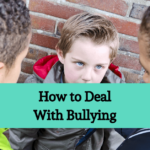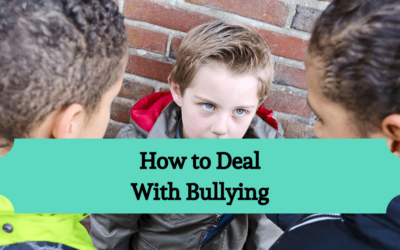When faced with a bully, the first question many parents ask is “why”. Why does someone choose to harm others, and more importantly, why their child? A growing epidemic, bullying has grown beyond the walls of the schoolroom to inside one’s home due to access to technology. It’s no longer a school day problem but a 24/7 issue that families face.
There are many reasons why a child decides to bully others. It could be from lack of attention at home or seeking revenge from being tormented themselves. Also, this child may be deflecting attention away from them and on to someone who appears weaker.
Table of Content:
This article is part of The Anti Bullying Guide article series
Chapter 1: How to Identify a Bully: The Ultimate Guide
Chapter 2: Bullying Facts: Guide for Parents and Educators
Chapter 3: Examples of Bullying
Chapter 4: Why do Kids Bully? (You are here)
Chapter 5: How To Deal with Bullying
Chapter 6: How To Stop Bullying
Chapter 7: Effects of Bullying and Cyber Bullying
Chapter 8: Stop Bullying Websites: Online Resource List
Why Are There Bullies?
Toxic Environment
Over the years, educators and experts have tried to solve the bullying issues in schools and within the community. Data even indicates that by a child’s 20th birthday, 1 in 2 children have faced bullying at least once.
Across the country, legislatures have adopted the definition that bullying is considered a form of aggression between two people or a group with a distinct difference of power. The aggressors’ actions create a toxic environment, both at school and within the home. Families now have to help their children through humiliation, anxiety, and harassment.
Need To Control
Some of the drives behind a bully’s action are their constant need for control. They seek relief from feeling helpless and feed off of overpowering others. Below are a few different forms of bullying:
- Social bullies have poor self-esteem and manipulate others through gossip and being mean
- Detached bullies plan their attacks and always likable to everyone but their victims
- Hyperactive bullies don’t understand how to socialize and misbehave and are sometimes physically.
Seeking Attention
If a child is not receiving love at home or lack rules and boundaries at home, they find bullying as a method to gain attention. Some find that the bully’s search for power is through their extravagant, exaggerated, and narcissistic self-assessments. Additionally, bullies can see their current situation as boring and underwhelming, and by bullying others, they feel entertained.
Popularity Contest
Some children may feel that they have the power to be mean because they are the “popular” kid amongst the group. They covet being accepted and, therefore, become more aggressive in their actions. Even though the behavior does not make any actual change, the child thinks that it does, which is why they continue to torment others.
Unfortunately, children can bond over the bullying and develop peer circles that support this aggressive behavior. Joining this type of group may make a child think that they are popular rather than receiving the label of a bully.
Bullying By Gender
Gender is a neutral factor, and there is a difference between girls and boys in how they choose to bully others. With girls, the trend is more gender-on-gender, while boys are more hostile towards girls versus the other way around as well as being hostile towards other boys.
Motivated By Revenge
Revenge is a motive used by kids instead of coping with specific situations. You may see this when a child turns from a victim to a bully. They want to inflict the same pain that they received from others and feel justified in doing so.
This type of bully may focus their revenge directly back towards the child who was their bully, or they may target a weaker, more vulnerable, kid. This child wants to feel more valuable and use bullying as their way to protect themselves. By using social aggression, they focus more on hurting others emotionally than physically to make themselves feel better.
School Rules
When a school’s don’t enforce their anti-bullying policy is not enforced, bullying is more likely to happen. If children know that the school rules are relaxed and there is inadequate supervision within the classrooms, hallways, cafeterias, or during recess.
Exposure To Violence
The imbalance of power is tough on everyone, and aggressive behavior is a learned trait. They may have older siblings at home that pick on them or are physically punished by their parents.
Another theory is that children who become bullies have seen violence from a young age. These actions can come directly from family members being violent in the homes or surrounding themselves with aggressive video games, TV shows, or movies.
Poor Impulse Control
Bullies can have poor impulse control when it comes to their feelings. They may not have the foresight to think about how others will feel due to their anger or physical actions.
Lack of Empathy
Bullies can have poor impulse control when it comes to their feelings. They may not have the foresight to think about how others will feel due to their anger or physical actions.
It is rare for bullies to reflect on how their teasing may hurt or harm the other child. Kids who are going through a negative stressors in their world find that they have a challenging time coping. It results as aggression or the person lashing out and taking out their frustration on others with very little consideration of anyone’s feelings but their own.
Strangers Can Be Bullies
Bullies are not necessarily people your child knows. Instead, the bully could be a child in a different grade or classroom or a different school and then randomly decide to make your son or daughter a target. With cyberbully, the possibilities are endless, as anyone can create a fake account and write hurtful comments behind a phony name.
Final Thoughts
As parents, it is vital to prepare for a bullying incident proactively, so you don’t panic if it happens to your family. Bullying methods are continually changing, yet there is an underlying theme of repeated aggression towards the victim. This type of trauma may occur either in person, over the phone,
in chat rooms, blog comment sections, or via social media platforms. Bullying incidents can impact a child’s health and mental state for years. The sooner the child can receive help both from their inner circle and professionally, the better.
Children should not carry the label of being a bullying victim forever; instead, they can enjoy a happy and fulfilling life.
Table of Content:
This article is part of The Anti Bullying Guide article series
Chapter 1: How to Identify a Bully: The Ultimate Guide
Chapter 2: Bullying Facts: Guide for Parents and Educators
Chapter 3: Examples of Bullying
Chapter 4: Why do Kids Bully? (You are here)
Chapter 5: How To Deal with Bullying
Chapter 6: How To Stop Bullying
Chapter 7: Effects of Bullying and Cyber Bullying
Chapter 8: Stop Bullying Websites: Online Resource List












0 Comments